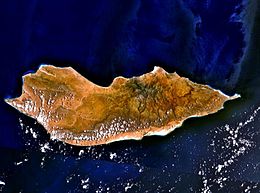
Back Sokotra Afrikaans ሱቁጥራ Amharic Socotra AN سقطرى Arabic Socotra AST Sokotra adası Azerbaijani Socotra BAN Сакотра BE-X-OLD Сокотра (остров) Bulgarian সুকাত্রা Bengali/Bangla
 Landsat view of Socotra | |
 | |
| Geography | |
| Location | Between the Guardafui Channel and the Arabian Sea |
| Coordinates | 12°30′36″N 53°55′12″E / 12.51000°N 53.92000°E |
| Archipelago | Socotra |
| Area | 3,796 km2 (1,466 sq mi) |
| Length | 132 km (82 mi) |
| Width | 50 km (31 mi) |
| Highest elevation | 1,503 m (4931 ft) |
| Highest point | Mashanig, Hajhir Mountains |
| Administration | |
| Region | |
| Governorate | Socotra Archipelago |
| Districts | Hadibu (east) Qulansiyah wa 'Abd-al-Kūrī (west) |
| Capital and largest city | Hadibu (pop. 8,545) |
| Demographics | |
| Population | 60,000 |
| Pop. density | 11.3/km2 (29.3/sq mi) |
| Ethnic groups | predominantly Soqotris; minority Yemenis, Hadharem, and Mehris |
Socotra (/səˈkoʊtrə, soʊ-, ˈsɒkətrə/; Arabic: سُقُطْرَىٰ Suquṭrā) or Saqatri (Soqotri: ساقطْري Saqaṭri) is an island in the Indian Ocean part of Yemen.[1][2] Lying between the Guardafui Channel and the Arabian Sea and near major shipping routes, Socotra is the largest of the six islands in the Socotra archipelago, which since 2013 constitutes one of Yemen's governorates.
The island comprises around 95% of the landmass of the Socotra archipelago. It lies 380 kilometres (205 nautical miles) south of the Arabian Peninsula and 240 km (130 nmi) east of Somalia, making it geographically a part of Africa.[3] Socotra is home to a high number of endemic species. Up to a third of its plant life is endemic. Due to the island's unusual geography, it has been described as "the most alien-looking place on Earth".[4] The island measures 132 km (82 mi) in length and 42 km (26 mi) across at its widest.[5] In 2008, Socotra was recognised as a UNESCO World Heritage Site.[6]
The island is under the de facto control of the Southern Transitional Council, a United Arab Emirates-backed, pro-Presidential Leadership Council (PLC), "secessionist" faction in Yemen's ongoing civil war.[7]
- ^ Burrowes, Robert D. (2010). Historical Dictionary of Yemen. Scarecrow Press. pp. 361–362. ISBN 978-0-8108-5528-1.
- ^ Robinson, Peg; Hestler, Anna; Spilling, Jo-Ann (2019). Yemen. Cavendish Square. p. 15. ISBN 978-1-50264-162-5.
- ^ "Socotra islands scenery in Yemen". youth.cn. China Youth International. 25 April 2008. Archived from the original on 5 September 2017. Retrieved 4 December 2009.
- ^ Huntingford, George Wynn Brereton (1980). The Periplus of the Erythraean Sea. Hakluyt Society. p. 103. ISBN 978-0-904180-05-3.
- ^ Abrams, Avi (4 September 2008). "The Most Alien-Looking Place on Earth". DarkRoastedBlend.com.
- ^ "EU to protect Socotra archipelago environment". SabaNews.net. Yemen News Agency. 15 April 2008.
- ^ "Yemen's Socotra, isolated island at strategic crossroads". The Economic Times. 7 June 2021. Retrieved 4 May 2022.

